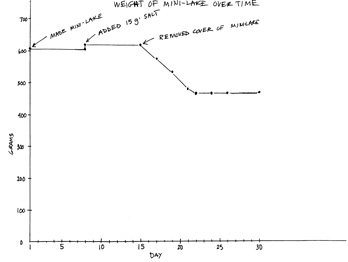How can we keep track of our mini-lake materials?
3. Make meaning
Review norms for science discussions
Explain that an important part of science is explaining our ideas and asking questions so we can all learn from each other. Remind students that it's important to listen to each other, support their ideas with evidence, and build on each other's ideas.
Purpose of the discussion
The purpose of this discussion is for students to jointly construct explanations for why the weight of the completed lake differs from the weight of the sum of its parts, and to understand the limitations of their digital scales.
Scales: The weight of the completed lake is likely to be different than the sum of the parts. Why? The classroom scales round weight to the closest gram. This means that, for each individual component of the mini-lakes, the measured weight can differ from the actual weight by plus or minus a half gram. The measured weight of the completed lake should be more accurate than the sum of the measured weights of the parts.
Engage students in the focus question
How do you explain the difference between the weight of the completed lake and the weight of the sum of its parts?

Ask students to return to the [Making mini-lakes] page in their Science Notebooks. Direct their attention to two places where they have recorded weight: the row in the table labeled Sum of the weights; and the line of text below the table that reads Weight of the completed mini-lake.
Did students get the same weight in both places? For most, the two numbers will be different.
Give students time to consider the data and offer responses; this is a challenging question. Listen carefully to student ideas, ask them to explain their reasoning, and encourage them to build on or add to each other's ideas.
Which weight do you think is more reliable, and why?
If no one mentions that the scales sometimes flickered between two weights, ask:
How many of you noticed your scale flickering back and forth between one number and another? For example, the scale might read 120 … 119 … 120 … 119 … 120.
- The weight was in between two numbers and the scale does not show fractions of a gram. Even when the scale is not flickering, the weight it displays is always rounded to the closest gram.
- Weighing the whole lake gives us a more reliable weight because it involves just one measurement, which could be inaccurate by as much as a half-gram. Weighing each of the 5 components means that there are 5 measurements, each of which could be inaccurate by as much as a half-gram.
Summarize the discussion and recap the investigation
Using the same language students have used, summarize their main ideas. Include the following key ideas:
- The classroom scales do not measure fractions of a gram so they are always rounding to the closest gram. This rounding is a possible source of error when using the scales.
- Because every measurement can be as much as a half–gram different than the actual weight, the weight of the completed mini-lake is likely to be more accurate than the sum of the weights of the different materials.
As you recap the investigation, be sure there is understanding of these points:
- The mini–lake is a simple, small version of a real lake.
- Measurements of the weight and volume will help students keep track of any changes that may occur over time.
- Today students considered possible sources of error in their measurements. They will continue to keep sources of error in mind throughout the unit.
Weighing the Mini-lakes
Students are asked to weigh their mini-lakes in just 6 of the 18 Investigations. However, collecting weight data more frequently - even daily - will give students a more complete story of how this system changes over time.
In Investigations 2, 5, and 7, the weighing is integral to the work, and should happen as part of those Investigations. Time for weighing the mini-lakes is also built into Investigations 8, 9, and 17, but the weighing is separate from the focus of those specific Investigations.
If possible, except for Investigations 2, 5, and 7, have students weigh their mini-lakes before school, just before science class, or during lunch or recess. This will allow students to collect the additional data, and will open up more time for discussions or writing in Investigations 8, 9, and 17.

A sneak preview:
The graph Weight of Mini-Lake over Time is an example of what students develop over the course of the next few weeks. Students add data points to the graph as they collect the data. They will not add explanation notes to the graph until after they have finished adding all of the data points.
Before Investigation 4: Introduce 315 Dots Per Page
Sometime before Investigations 4 or 5, set aside five minutes, outside of science class, to introduce 315 Dots per Page. Let this experience stand on its own for now. This gives students time to mull over the idea that when very tiny particles (or dots) are widely spread apart from one another, they are too small and too spread out to see.
When they get to Investigation 5, students find their experience with the dot sheets helpful as they try to explain why dissolved salt is invisible. The experience can also help them explain why water particles become invisible after evaporation.



